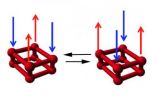(Press-News.org) Perhaps not everyone knows that oxygen has – quite unusually for such a simple molecule – magnetic properties. The phase diagram of solid oxygen at low temperatures and high pressures shows, however, several irregularities (for example, proper "information gaps" with regard to these magnetic properties) that are still poorly understood. A team of researchers from the International School for Advanced Studies (SISSA) and International Centre for Theoretical Physics Abdus Salam (ICTP) of Trieste, while trying to understand the origin of these phenomena, have identified a new phase, in which oxygen exhibits previously unknown characteristics.
The magnetism of oxygen is related to the spin of its electrons. "In each molecule two electrons align their intrinsic spin and magnetic moment, spin 1/2, giving rise to a spin 1 magnetic moment", explains Erio Tosatti, professor at SISSA and among the authors of the paper just published in PNAS. "At very high pressures, however, the world goes upside down", he jokes, "insulators become superconductors, magnetic materials lose their properties and so on. Like oxygen, for example: while exhibiting magnetic properties at intermediate pressures, oxygen molecules lose their magnetism at pressures above 80,000 atmospheres. Or at least that's what we used to think, because our studies suggest that the situation is more complex than that".
The first non-magnetic phase, called epsilon, has been studied for years. "Scientists didn't understand what was going on", continues Tosatti. "A few years ago, it became clear, first experimentally and then theoretically, that this loss of magnetism is caused by the sudden grouping of molecules into 'quartets', in turn related to some sort of 'reluctance' of oxygen to become metallic". At even higher pressures (one million atmospheres) oxygen takes on a metallic form and becomes a superconductor. "The formation of quartets with loss of magnetism could be defined as a gimmick used by oxygen to delay becoming metallic. An interesting explanation, but some inconsistencies in the epsilon-phase data at 'lower' pressures, just above 80,000 atmospheres, prompted our group to delve deeper into the matter", explains Tosatti. Tosatti, together with Michele Fabrizio from SISSA, Yanier Crespo from ICTP and Sandro Scandolo, also from ICTP, performed very delicate and extensive calculations and developed quantum models specifically to understand this corner of the phase diagram".
More in detail...
"Our study demonstrated that the epsilon phase is actually divided into two phases and that in the first, from 80,000 to 200,000 atmospheres, which we called epsilon 1, the quartet molecules engage in a real 'quantum dance'".
The four scientists observed, in fact, that the four oxygen molecules in each group constantly exchanged magnetic moments. "It's as if the molecules were playing ball with their spins, the direction in which the electrons rotate around their axis, continuously passing the ball to one another, so that the mean value of each molecule's moment and magnetism is zero. In the epsilon 1 phase of oxygen, the molecules retain their spins, but these fluctuate coherently within and across quartets like a chorus of cicadas", explains Tosatti.
Based on these observations, it isn't true that oxygen in epsilon 1 phase has no magnetic properties, it's just that they hadn't been calculated or measured clearly. "Following our results we checked the literature on the subject and found experimental findings consistent with our model, but which had so far been regarded as anomalies" specifies Tosatti.
This study therefore divided the epsilon phase into two, epsilon 1 (from 80,000 to 200,000 atmospheres), with fluctuating magnetic properties, and epsilon 0 (from 200,000 to 1,000,000 atmospheres), without magnetic properties. "We considered a new transition line between the two phases, perhaps with a critical point, which would be unprecedented in this context. There are also other implications, for example as regards the magnetic response and dissipation present in epsilon 1 but not in epsilon 0", explains Tosatti. "Now we hope to prompt the experimental physicists to verify all these new data".
INFORMATION: END
The quantum dance of oxygen
Proposal for a new phase of the element, where atoms dance in quartets
2014-07-07
ELSE PRESS RELEASES FROM THIS DATE:
DNA of 'Evolution Canyon' fruit flies reveals drivers of evolutionary change
2014-07-07
Scientists have long puzzled over the genetic differences between fruit flies that live hardly a puddle jump apart in a natural environment known as "Evolution Canyon" in Mount Carmel, Israel.
Now, an international team of researchers led by scientists with the Virginia Bioinformatics Institute at Virginia Tech has peered into the DNA of these closely related flies to discover how these animals have been able to adapt and survive in such close, but extremely different, ecologies.
One reason lies in a startling abundance of repetitive DNA elements that, until recently, ...
High earners in a stock market game have brain patterns that can predict market bubbles
2014-07-07
If you're so smart, why aren't you rich? It may be that, when it comes to stock market success, your brain is heeding the wrong neural signals.
In a study in the Proceedings of the National Academy of Sciences this week, scientists at the Virginia Tech Carilion Research Institute and Caltech found that, when they simulated market conditions for groups of investors, economic bubbles — in which the price of something could differ greatly from its actual value — invariably formed.
Even more remarkably, the researchers discovered a correlation between specific brain activity ...
Negar Sani solved the mystery of the printed diode
2014-07-07
VIDEO:
The video shows how a printed label picks up the radio signal from a telephone making a call, and uses the energy to switch the integrated display. This is only...
Click here for more information.
With an article published in the Proceedings of the National Academy of Sciences in the United States of America (PNAS), a thirteen-year-long mystery that has involved a long series of researchers at both Linköping University and Acreo Swedish ICT has finally been solved.
The ...
Neuroeconomists confirm Warren Buffett's wisdom
2014-07-07
Investment magnate Warren Buffett has famously suggested that investors should try to "be fearful when others are greedy and be greedy only when others are fearful."
That turns out to be excellent advice, according to the results of a new study by researchers at Caltech and Virginia Tech that looked at the brain activity and behavior of people trading in experimental markets where price bubbles formed. In such markets, where price far outpaces actual value, it appears that wise traders receive an early warning signal from their brains—a warning that makes them feel uncomfortable ...
Smart and socially adept
2014-07-07
Wanted: Highly skilled individual who is also a team player. In other words, someone who knows his or her stuff and also plays well with others.
Two qualities are particularly essential for success in the workplace: book smarts and social adeptness. The folks who do well tend to demonstrate one or the other. However, according to research conducted by UC Santa Barbara economist Catherine Weinberger, the individuals who reach the highest rungs on the corporate ladder are smart and social. Her findings appear in a recent online issue of the Review of Economics and Statistics.
Weinberger, ...
The tortoise and the hare: A sex difference in marathon pacing
2014-07-07
ALLENDALE, Mich. — Men are more likely than women to slow their pace in the marathon, according to a new study led by a Grand Valley State University researcher. The findings were published in Medicine & Science in Sports & Exercise.
The study, led by Robert Deaner, associate professor of psychology at Grand Valley State, was based on 14 marathons that occurred in the U.S. in 2011, and it included almost 92,000 performances. On average, men ran the second half of the marathon 15.6 percent slower than the first half, whereas women slowed by an average of 11.7 percent. ...
Slim down for the health of it and possibly reduce your hot flashes in the process
2014-07-07
CLEVELAND, Ohio (July 7, 2014)—Now women have yet one more incentive to lose weight as a new study has shown evidence that behavioral weight loss can help manage menopausal hot flashes.
The pilot study, which was published online last month in Menopause, the journal of The North American Menopause Society (NAMS), consisted of 40 overweight or obese white and African-American women with hot flashes, which are the most prevalent symptom of menopause. In fact, more than 70% of women report hot flashes during the menopausal transition, with many of these women reporting frequent ...
US scientists don't publish articles about potential role of innate variation in athletic performance
2014-07-07
ALLENDALE, Mich. — Compared to scientists working in other countries, U.S.-based scientists are underrepresented as authors of articles on the potential role of innate variation in athletic performance that are published in peer-reviewed science journals, according to Grand Valley State University researchers.
The findings are published in the online journal SpringerPlus.
The research, conducted by Michael P. Lombardo, professor of biology, and Shadie Emiah, a Grand Valley State graduate student, used information about the authors of 290 articles published in peer-reviewed ...
Of non-marijuana drug users in the ER, nearly all are problem drug users
2014-07-07
WASHINGTON —Of emergency patients who reported any drug other than marijuana as their primary drug of use, 90.7 percent met the criteria for problematic drug use. Among patients who reported cannabis (marijuana) as their primary drug, almost half (46.6 percent) met the criteria for having a drug problem, according to a study published online Thursday in Annals of Emergency Medicine ("Identifying Patients with Problematic Drug Use in the Emergency Department: Results of a Multi-Site Study.)
"Of patients who reported any drug use in the previous 30 days, nearly two-thirds ...
Sitting too much, not just lack of exercise, is detrimental to cardiovascular health
2014-07-07
Dallas – July 7, 2014 – Cardiologists at UT Southwestern Medical Center found that sedentary behaviors may lower cardiorespiratory fitness levels. New evidence suggests that two hours of sedentary behavior can be just as harmful as 20 minutes of exercise is beneficial.
The study, published in today's online edition of Mayo Clinic Proceedings, examined the association between fitness levels, daily exercise, and sedentary behavior, based on data from 2,223 participants in the National Health and Nutrition Examination Survey (NHANES).
Sedentary behavior involves low levels ...
LAST 30 PRESS RELEASES:
Numbers in our sights affect how we perceive space
SIMJ announces global collaborative book project in commemoration of its 75th anniversary
Air pollution exposure and birth weight
Obstructive sleep apnea risk and mental health conditions among older adults
How talking slows eye movements behind the wheel
The Ceramic Society of Japan’s Oxoate Ceramics Research Association launches new international book project
Heart-brain connection: international study reveals the role of the vagus nerve in keeping the heart young
Researchers identify Rb1 as a predictive biomarker for a new therapeutic strategy in some breast cancers
Survey reveals ethical gaps slowing AI adoption in pediatric surgery
Stimulant ADHD medications work differently than thought
AI overestimates how smart people are, according to HSE economists
HSE researchers create genome-wide map of quadruplexes
Scientists boost cell "powerhouses" to burn more calories
Automatic label checking: The missing step in making reliable medical AI
Low daily alcohol intake linked to 50% heightened mouth cancer risk in India
American Meteorological Society announces Rick Spinrad as 2026 President-Elect
Biomass-based carbon capture spotlighted in newly released global climate webinar recording
Illuminating invisible nano pollutants: advanced bioimaging tracks the full journey of emerging nanoscale contaminants in living systems
How does age affect recovery from spinal cord injury?
Novel AI tool offers prognosis for patients with head and neck cancer
Fathers’ microplastic exposure tied to their children’s metabolic problems
Research validates laboratory model for studying high-grade serous ovarian cancer
SIR 2026 delivers transformative breakthroughs in minimally invasive medicine to improve patient care
Stem Cell Reports most downloaded papers of 2025 highlight the breadth and impact of stem cell research
Oxford-led study estimates NHS spends around 3% of its primary and secondary care budget on the health impacts of heat and cold in England
A researcher’s long quest leads to a smart composite breakthrough
Urban wild bees act as “microbial sensors” of city health.
New study finds where you live affects recovery after a hip fracture
Forecasting the impact of fully automated vehicle adoption on US road traffic injuries
Alcohol-related hospitalizations from 2016 to 2022
[Press-News.org] The quantum dance of oxygenProposal for a new phase of the element, where atoms dance in quartets





